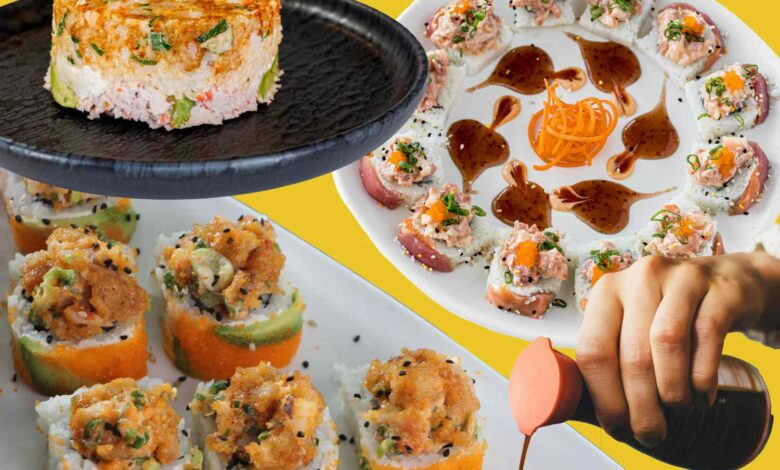Mexico’s Wild Reinvention of Sushi Is Spicy, Cheesy, and Totally Delicious

I live in the Mexican state of Sinaloa, a long strip along the Pacific coast where no city sits more than 100 miles from saltwater. Here, seafood is not just cuisine—it’s culture. Aguachile, ceviche, pescado zarandeado, shrimp tacos: these are the mainstays of a regional identity built on freshness and flavor. And then, there’s the sushi.
Traditional Japanese sushi is often considered a minimalist art form, emphasizing balance and the purity of each ingredient. But Sinaloan sushi is something else entirely: maximalist, bold, and unapologetically over the top. A roll might include carne asada or fried chicken, be smothered in cheese and chipotle sauce, or arrive baked, battered, or ablaze with spicy mayo. It’s easy to see why Sinaloan-style sushi inspires strong opinions. But it has more to offer than shock value. Done well, it is a genuinely delicious fusion cuisine.
It’s a familiar story: As long as there have been diasporas, chefs and home cooks have had to feed their communities in new places. And when people make old recipes with foreign and unfamiliar ingredients, rich new cuisines begin to take shape.
Despite its departure from Japanese tradition, Sinaloan sushi has become one of the region’s most beloved culinary exports, both wildly inventive and deeply reflective of local taste. On weekend nights in Culiacán, it’s not uncommon to see lines spilling from sushi carts, their counters glowing under fluorescent lights, with orders packed into Styrofoam trays and topped with blistered chiles or neon-orange Tampico, a creamy topping made with imitation crab and chiles. Sushi is everywhere in Sinaloa’s food landscape—next to burger joints, outside clubs, on sleepy suburban blocks.
Serious Eats/ Eduardo Esparza
A Global Food on the Move
Sushi’s global journey began in 19th-century Japan, where it was sold from pushcarts to a bustling merchant class. When it first arrived in the U.S. in the 1960s, it was introduced at Kawafuku in Los Angeles, an upscale spot that catered to Japanese expatriates and diplomats. From there, sushi was reinterpreted to fit local palates, giving rise to innovations like the California roll (arguably invented in Vancouver) and setting the stage for its worldwide spread.
Mexico was part of that journey, though sushi’s integration here followed a unique path. In western Mexico, especially along the Pacific coast, a small but influential Japanese-Mexican community had already formed by the early 20th century. Many early Japanese immigrants in Sinaloa were engineers, doctors, and agricultural workers. Some settled in coastal towns like Escuinapa and Mazatlán, where they brought not only their language and customs but also their food. While sushi would become the most visible legacy, Japanese pickling, fermentation, and rice cultivation also shaped the regional palate. Some came directly from Japan after the Russo-Japanese War; others arrived from the U.S. seeking relief from anti-Asian property laws.
In Culiacán, the Taniyama family—a prominent Japanese Mexican family—opened one of the city’s first sushi restaurants, Tomo, in 1988. At first, their clientele was primarily members of the Japanese community, but the restaurant also became a training ground for the city’s earliest non-Japanese sushi chefs.
Serious Eats/ Eduardo Esparza
Reinventing the Roll: The Sushi Cart Revolution
One of those chefs was Fausto Quevedo. After training at Tomo, he dreamed of opening his own place. His brother-in-law, Héctor López, pitched a different idea: a sushi cart. Skeptical but intrigued, Quevedo agreed, and together they launched Sushi-to in 1992. Inspired by the ubiquitous taco stands that dot Culiacán’s streets, they brought sushi to the sidewalk—affordable, fast, and eye-catching.
At first, business was slow. Locals turned up their noses at unfamiliar dishes, confusing sushi with tacos de buche or outright rejecting raw fish. “Raw fish? No thanks,” Quevedo recalled hearing again and again. But curiosity grew, and within a year, Sushi-to couldn’t keep up with demand. Imitators followed, and soon sushi carts were everywhere. Today, nearly 75% of Culiacán residents live within a five-minute walk of a sushi vendor.
Quevedo’s genius was not just in marketing but in adapting sushi to local cravings. Take the Mar y Tierra roll: a deep-fried fusion of carne asada and shrimp, born when a reluctant customer admitted he hated fish but liked beef. The roll was a hit—and a harbinger of the over-the-top creations to come.
The craze for this kind of sushi quickly spread beyond Culiacán. Rosario Valdez, a former sushi cart entrepreneur in the Sinaloan resort town of Mazatlán, recalled being overwhelmed with clients soon after opening her cart in the early aughts. As she described, the “trend of regionalized sushi” fit perfectly into existing street food culture. Instead of stepping out to grab a taco or passing by a hot dog cart after a night of bar-hopping, hungry city-dwellers now had a new quick bite to eat.
Sinaloan Innovation: Sushi, Maxed Out
Sinaloan sushi rapidly evolved into its own genre. Rolls might feature chicken, bacon, cheese, and spicy surimi paté (Tampico). Others come baked, fried, or topped with aguachile—a citrusy chile-laced marinade traditionally used for shrimp. Common ingredients include imitation crab (kanikama), cucumber, avocado, cream cheese, and spicy mayo. Some signature creations include:
- Guamuchilito Roll: Cucumber, avocado, imitation crab sticks (kanikama), and shrimp or octopus, with Tampico topping.
- Cordon Bleu Roll: Chicken, bacon, and cheese.
- Curricanes: Tuna sashimi wrapped around avocado, cucumber, and kanikama.
The Guamuchilito roll, named for the town of Guamúchil, exemplifies the region’s layered approach: something creamy, something crunchy, something spicy. The Cordon Bleu roll riffs on the Western classic with breaded chicken, bacon, and molten cheese, all rolled up with sushi rice and seaweed. Whether baked or fried, the goal is always the same: richness, heft, and heat.
At upscale restaurants, you’ll find edamame and miso soup alongside local twists like koikas (surimi-stuffed calamari) and roasted chile caribe. Soy sauce and eel sauce sit next to fiery salsas and fresh wasabi. Tampico, the spicy orange surimi paste on top of so many rolls, has become a kind of regional shorthand—chefs might top even classic rolls with a dollop “just to make it monchoso” (slang for a more extreme approach to food—more on that below).
Even sushi purists in the region admit its appeal. Miguel Taniyama, son of Tomo’s founder, acknowledged the popularity of Mexicanized sushi. “It might bother some of us purists, but it’s a reality—it’s successful … it keeps spreading and crossing borders.”
Chef Yasuo Asai, a Japanese culinary ambassador in Mexico City, was more ambivalent. “The cream cheese, avocado, doing fried stuff…people like it, but for me as a Japanese chef, I would say it’s a totally different category,” he said. And yet, he conceded, “Sushi is already the one Japanese food worldwide…like pizza, so it’s okay to expand sushi all around the world.”
Serious Eats/ Eduardo Esparza
The Rise of Monchosidad
In Sinaloa, this maximalist style has a name: monchoso. The word doesn’t quite translate, but it captures the pleasure of overindulgence—a craving for rich, excessive food, and engineered to satisfy every sensory urge. It’s not uncommon to see rolls covered in three kinds of melted cheese or to find sushi hot dogs and sushi burritos on menus. One viral roll made the rounds on TikTok last year: a tempura roll layered with ham, bacon, Tampico, chipotle, and a fiery drizzle of Sinaloan aguachile, then torched tableside for good measure. “It’s like five cravings at once,” one commenter said. Another just posted fire emojis.
Wicho Ruelas, a Sinaloa-based restaurateur, sees it all as part of a spectrum. His sushi empire spans traditional Japanese offerings at Zen and fusion-forward rolls at Zasshi. “There’s a line, and there are places that overdo it…but it’s part of the culture in Sinaloa—and even more so in Culiacán.”
Quevedo, now a seasoned veteran of the sushi business, admits he still prefers traditional Japanese sushi—but he’s pragmatic. “I’m a businessman. My idea is to give the client what they ask for. In Culiacán, the palate is monchoso—it’s demanding.”
Beyond the Cart: Going Global
Sinaloan sushi’s success didn’t stop at state lines. Chains like Culichitown have brought it to the U.S., with outposts in California, Texas, Illinois, and beyond. At Culichitown, the experience is half-club, half-cantina, with banda music blasting and Micheladas served in goblets. It’s dinner and a show, with Mar y Tierra rolls coming out hot from the fryer and servers dancing as they deliver flaming sushi boats to birthday tables.
Smaller shops, like Mariscos y Sushis Los Tomateros in Los Angeles, are cropping up too. “In Sinaloa, they say every block has a sushi place,” said owner Edgar Baca. “At the rate we’re going, it looks like it’s going to be the same here.” He said his Lynwood spot draws in nostalgic Sinaloans and curious Angelenos alike. “We sell a ton of Guamuchilito rolls,” he added. “People always ask for extra chipotle mayo. Always.”
Mexico City chef Aquiles Chávez said, “It’s very adapted to the Mexican idiosyncrasies and palate. It’s more monchoso, more flavorful, more delicious.”
He’s right. Whether you want something wild like a deep-fried Mar y Tierra roll or a delicate piece of tuna nigiri finished with serrano chile and eel sauce, Sinaloan sushi delivers. The style varies by city block, let alone by region. Some places still revere the traditional rice and vinegar techniques; others are playing mad scientist.
The last roll I ordered in Culiacán came wrapped in salmon, topped with Tampico, and finished with a caramelized chile-soy glaze. It was outrageous—and genuinely great. The one before was a delicate tuna nigiri finished with serrano chile, just enough heat to make your lips buzz. The extremes live side by side here, and that’s what makes it exciting.
Sinaloan sushi is more than fusion—it’s a story of adaptation, entrepreneurship, and cultural remixing. Its evolution tells us what happens when local craving meets global cuisine. I’m writing this in the spring of 2025; by the time you read it, there’ll be a new roll on the streets. Maybe it’ll be delicious. Maybe it’ll be dubious. But I can’t wait to try it.
Serious Eats/ Eduardo Esparza





